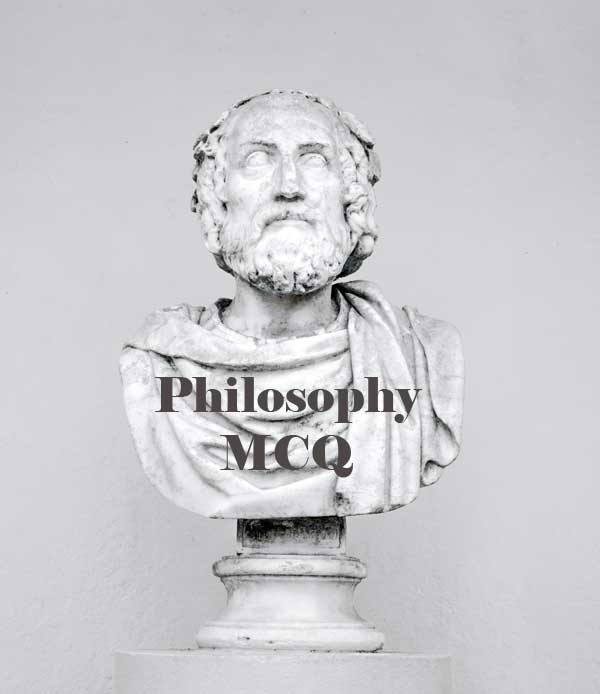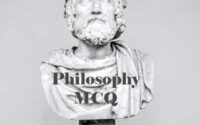Philosophy Model Question Papers
On this page, Applicants can check the below links for downloading the Philosophy Model Question Papers. The Philosophy Model Question Papers will be helpful for the applicants in their preparation.

Hence, the people can begin the practice by downloading Philosophy Model Question Papers. The Philosophy Model Question Papers may not contain the originally asked questions. Free downloading links of the Philosophy Model Question Papers are enclosed below.
Model Question on Philosophy
1. Which one of the following statements is true with regard to theory of causation of Vedanta?
(A) Vivartavada is compatible with arambhavada
(B) Vivartavada is incompatible with satkaryavada
(C) Satkaryavada is incompatible with parinamavada
(D) Vivartavada is compatible with satkaryavada
2. The Manas is that substance which is independent and is atomic in size. This view is held by:
(A) Nyaya-Vaisesika
(B) Carvaka
(C) Advaita Vedanta
(D) Mimamsa
3. Examine the following statement and choose the fallacy immanent in it:
“Fire is cold because it is a substance.”
(A) Badhita
(B) Virudha
(C) Satpratipaksha
(D) Savyabhichara
4. Which one of the following is the causal potency that propels the man to perform the actions enjoined by the Veda?
(A) Arthavada
(B) Bhavana
(C) Nisedha
(D) Vidhi
5. Which one of the following is not a part of the triple path prescribed by the Buddhism?
(A) Prajna
(B) Jnana
(C) Sila
(D) Samadhi
6. Which one of the following combinations of theory of error and its advocator is wrongly matched?
(A) Satkhyati — Ramanuja
(B) Anirvachaniya Khyati — Shankara
(C) Anyathakhyati — Prabhakara
(D) Asatkhyati — Madhyamika Buddhism
7. Sartre’s notion of freedom negotiates between:
(A) facticity and responsibility
(B) facticity and nihilism
(C) facticity and indeterminism
(D) facticity and immanence
8. In his ‘Republic’ Plato introduces the tripartition of the soul to address:
(A) Individual conflict
(B) Political conflict
(C) Educational conflict
(D) Psychological conflict
9. Aristotle upholds that the formal, efficient and final causes are:
(A) neither identical nor different
(B) both identical and different
(C) identical
(D) different
10. According to Kant, the idea of God and immortality are:
(A) Innate ideas
(B) Objects of intuition
(C) Ideas of reason
(D) Ideas of imagination
11. Which of the following books is not authored by Rene Descartes?
(A) Discourse on Method
(B) Meditation on First Philosophy
(C) Principles of Philosophy
(D) An Essay Concerning Human Understanding
12. Which of the following philosophers infers the self-existence based upon thinking?
(A) Immanuel Kant
(B) John Locke
(C) Jean-Paul Sartre
(D) Rene Descartes
13. Who advocates that clarity and distinctness are the qualities of knowledge?
(A) Plato
(B) Aristotle
(C) Rene Descartes
(D) David Hume
14. Who said, ‘mind is the idea of body’?
(A) John Locke
(B) Spinoza
(C) Rene Descartes
(D) Plato
15. Who is the author of ‘Letters Concerning Toleration’?
(A) John Locke
(B) Hobbes
(C) David Hume
(D) Leibniz
16. “Tattvamasi”, according to Madhva, means:
(A) Tasya tvam asi
(B) Tasmin tvam asi
(C) Tena tvam asi
(D) Tasmat tvam asi
17. Which of the following is a feature of Sthitaprajna mentioned in Bhagvad Gita?
(A) Sam Dukhe Same Krutva
(B) Tat tvam asi
(C) Aham Brahmasmi
(D) Dharayati iti Dharmah
18. Select the correct alternative which postulates for the moral intelligibility of the universe:
(A) Karma and Dharma
(B) Law of Karma and Rebirth
(C) Astanga-marga
(D) Astangika-marga
19. Dharma does not mean:
(A) Attributes
(B) Constituents of reality
(C) Detachment
(D) Duties, Virtue, Merit
20. According to the Samkhyas , Dharma signifies a specific function of the:
(A) Mind
(B) Ego
(C) Intellect
(D) Mahat
More Question Papers on Philosophy
| Question Papers | Question Bank |
| MCQ Objective | Practice Set |
| Selected Question | Mock Test |
| Typical Question | Old Questions |
| Test Papers | Sample Papers |
| Important Question | Model Question |
21. Tilak insists that Sthitaprajna should:
(A) Renounce the world
(B) Work in the world
(C) Work in renunciation
(D) Work renouncing the attachment to the fruits of actions
22. While interpreting Bhagavad- gita , the concept of ‘Niskama karma’ is underlined by:
(A) Tilak
(B) Madhva
(C) Madhva and Tilak
(D) Neither Madhva nor Tilak
23. Which of the following does not fit with Moore’s defence of common sense?
(A) ‘In this universe there are many material objects.’
(B) ‘Men perform acts of consciousness.’
(C) We know the objects and acts of consciousness.
(D) There are evidences for our belief regarding external world.
24. Cross the odd one out keeping in mind Jaina Ethics:
(A) Jiva, Ajiva, Asrava
(B) Asrava, Bandha, Samvara
(C) Samvara, Nirjara, Moksa
(D) Kamma, Kusala Kamma, Akusala Kamma
25. ‘‘Sthitaprajna’’ is described in the Gita as one who controls the senses like a:
(A) Lion
(B) Tortoise
(C) Snake
(D) Crow
26. Hedonistic calculus is proposed by:
(A) J.S. Mill
(B) Bentham
(C) Sidgwick
(D) Kant
27. “Ethical sentences are primarily emotion expressions of one’s own attitudes and are intended to influence the actions of the listeners” — can be attributed to which one of the following philosophers?
(A) Bentham
(B) Sidgwick
(C) A.J. Ayer
(D) Kant
28. Which one of the following theories of punishment views crime in terms of its contributing conditions and argues for the changing these conditions that punishing the offender?
(A) Deterrent theory
(B) Retributive theory
(C) Preventive theory
(D) Reformative theory
29. Which of the following best summarizes Kant’s possible criticism of Egoism as a theory of Ethics?
(A) Ethical egoism is logically selfcontradictory
(B) Egoism involves conflict of will
(C) Egoism involves wrong view of human nature
(D) One cannot will the egoistic maxim to be a universalized
30. The primacy of character over action is asserted in:
(A) Traditional ethics
(B) Meta-ethics
(C) Ethics of care
(D) Virtue-ethics
31. Which among the following is a true statement with regard to Egoism as an ethical theory?
(A) Ethical egoism presupposes psychological egoism
(B) Ethical egoism does not presuppose psychological egoism
(C) Psychological egoism is identical with psychological hedonism
(D) Psychological egoism and psychological hedonism are two contradictory positions
32. Which of the following statements is not true of Act-deontological theory of Ethics?
(A) Particular judgements are basic and any general rules are to be derived from them, not the other way around.
(B) It presents a method determining what is right by becoming clear about facts in the case and then forming a judgement about action.
(C) We cannot form a thumb of rule judgement without taking stock of concrete situation.
(D) Act-deontology is a position that implicitly assumes hedonism.
33. Happiness is construed by Hedonistic egoism as:
(A) Maximisation of pleasure and minimization of pain
(B) Bliss
(C) Maximization of one’s own pleasure
(D) Maximization of pleasure of maximum number of people
34. For Vivekananda, Religion is:
(A) Being and Becoming
(B) Hearing
(C) Acknowledging
(D) Listening
35. Samkara’s Mayavada is criticized on seven grounds by:
(A) Ramanuja
(B) Vallabha
(C) Madhva
(D) Nimbarka
36. Saccidananda is the ……………………. of Brahman.
(A) Description
(B) Main feature
(C) Negative characterization
(D) Essential nature
37. Which of the following is not maintained by Samkara?
(A) Pratibhasika
(B) Anekantika
(C) Vyavaharika
(D) Paramarthika
38. According to Ramanuja , the worldprocess is the outcome of:
(A) Pancikarana
(B) Trivrtkarana
(C) Aprthaksiddhi
(D) Brahman
39. Who among the following thinkers speaks of possibility of the consciousness of the denial of T?
(A) K.C. Bhattacharyya
(B) Vivekananda
(C) Sri Aurobindo
(D) Radhakrishnan
40. Which of the following is not true of Iqbal’s conception of God?
(A) God is immanent
(B) God is transcendent
(C) Constantly creative and dynamic
(D) God is irrelational
41. In Sri Aurobindo’s philosophy “that state of common self-existence in which the knower and the known are one through knowledge” refers to which of the following?
(A) Reason
(B) Intuition
(C) Intentionality of consciousness
(D) Supraintentional consciousness
42. “This human body is the greatest body in the universe, and a human being the greatest being” is said by:
(A) Radhakrishnan
(B) Sri Aurobindo
(C) Tagore
(D) Swami Vivekananda
43. In ‘Republic’ of Plato which of the following is not a reason why philosophers should rule a city?
(A) They hate poetry
(B) They hate falsehood
(C) They love what is rather than what becomes
(D) They are quick learners
44. In Moore’s critique of Hegelian Idealism, the main tenet under attack is:
(A) “All relations are internal to their terms.”
(B) “All relations are external to their terms.”
(C) “Relations are both internal and external.”
(D) “There is no distinction between internal and external relations.”
45. Ryle’s phrase ‘the ghost in the machine’ was designed to characterize a mythical view, which he attributed to:
(A) Aristotle
(B) Descartes
(C) Strawson
(D) Wittgenstein
46. Carnap upholds:
(A) Correspondence theory of truth
(B) Coherence theory of truth
(C) Pragmatic theory of truth
(D) Semantic theory of truth
47. According to early Wittgenstein a name denotes:
(A) a mental state
(B) a fact
(C) a physical object
(D) a simple
48. Russell’s theory of descriptions makes a distinction between two forms of a sentences:
(A) Grammatical and Semantical
(B) Grammatical and Logical
(C) Grammatical and Syntactical
(D) Syntactical and Semantical
49. Kierkegaard’s notion of truth as subjectivity is related to:
(A) direct communication
(B) rational communication
(C) propositional communication
(D) indirect communication
50. According to Heidegger, the human being belongs to Being as:
(A) a guardian
(B) a creator
(C) a master
(D) an author

